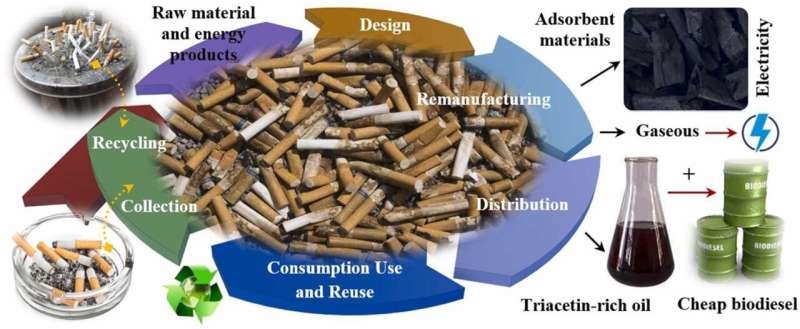This article has been reviewed according to Science X's editorial process and policies. Editors have highlighted the following attributes while ensuring the content's credibility:
fact-checked
trusted source
proofread
Recycling cigarette waste to produce green fuel

Stricter environmental norms and fossil fuel pollution call for cleaner fuels such as biodiesel. This vegetable oil- or animal fat-based diesel is biodegradable—up to four times faster than petroleum diesel—and nontoxic.
However, the high production cost of biodiesel remains a major barrier to its wider applicability, and, depending on the biomass source, using it may cause pollution. Adding a blender such as a triacetin compound, can solve both of these issues, according to research. Unfortunately, triacetin is usually produced chemically, consuming a lot of chemicals, and resulting in waste and toxic residues.
"Triacetin is used as a plasticizer in cigarettes' filter, so, naturally, cigarette butts are rich in it," says Samy Yousef, a chief researcher at Kaunas University of Technology, Lithuania.
Together with his colleagues from the Lithuanian Energy Institute (LEI), he conducted a series of experiments where they used pyrolysis to thermally decompose cigarette waste. The experiments were carried out in a 200 g reactor at different reaction temperatures (650, 700, and 750°C). The biggest quantity of triacetin (43%) was synthesized at 750°C.
Original approach to toxic waste
Smokers around the world buy roughly 6.5 trillion cigarettes each year. The average weight of a cigarette butt is 0.2 g; more than 1.1 million tons of them are produced annually. Cigarette waste contains extensive amounts of toxic chemicals, carcinogens, microplastic fibers, and radioactive elements that need special attention.
"In our research group, we are working on the topics of recycling and waste management, therefore we are always looking for the waste, which is present in huge amounts and has a unique structure. Cigarettes are made of three components—tobacco, paper and a filter made of cellulose acetate fibers—and are a good source of raw materials and energy. Plus, cigarette butts are easy to collect as there are many systems and companies for collecting this waste in place," explains Yousef.
Although there have been attempts to recycle cigarette waste for the extraction of raw materials, the majority of studies focused on the investigation of thermal degradation of the individual components. Lithuanian scientists in their experiments were treating cigarette butts as a mixture, and, according to them, it is an original approach.
"There are studies which, similarly to us, are using pyrolysis as a method but they are applying it to filter components only. In this case, the pre-treatment of the material is needed to separate all components. Since tobacco is a toxic waste, the disposal of it requires special care, and due to the technologically complicated process to separate the components of the cigarette waste, this is not economically feasible," says Yousef, a chief researcher at KTU Faculty of Mechanical Engineering and Design.
All products have real applications
After a series of pyrolysis at different temperatures experiments, the researchers were able to extract oil (38–39.5 wt%), char (25.7–27.7 wt%) and gas (33–36.4 wt%) from cigarette waste. The char product with a porous structure was very rich in calcium (up to 32 wt%).
"All the products have real applications. Char, which, in our case is porous and very rich in calcium can be used for fertilizers, or wastewater treatment as an absorbent, and energy storage. Gas can be used for energy purposes. Last, but not least is oil, rich in triacetin, which can be used as an additive to biodiesel to reduce the cost," says Yousef, who believes that the technology has great upscaling possibilities.
For any emerging waste treatment technology to be integrated into a circular economy system, there must be a waste collection system and recycling strategy, as well as infrastructure present.
Cigarette butts' collection systems, e.g., metal wastebaskets and ashtrays, are used widely to collect them separately from solid waste. As for the recycling strategy, the researchers propose using pyrolysis treatment at 750°C, which thermally converts cigarette butts into char, gas, and oil.
Gaseous products can be used to generate electricity and to power the conversion plant, char can be used as absorbents, while oil can be added to biofuels at a rate of up to 25% since the allowable triacetin rate is 10%.
Meanwhile, KTU researcher Yousef says that the group is researching other possibilities for using cigarette waste. The study is published in the Journal of Analytical and Applied Pyrolysis.
More information: Samy Yousef et al, Pyrolysis of cigarette butts as a sustainable strategy to recover triacetin for low-cost and efficient biodiesel production, Journal of Analytical and Applied Pyrolysis (2023). DOI: 10.1016/j.jaap.2023.106167
















